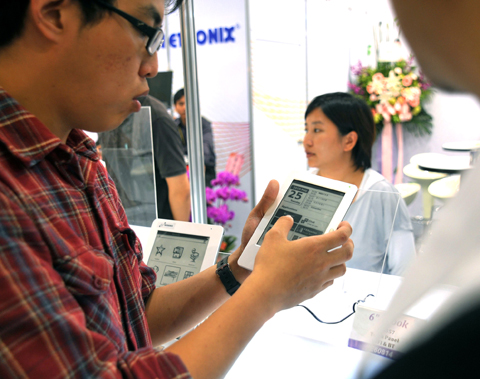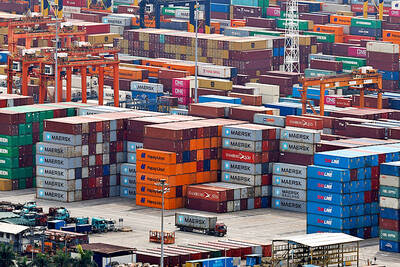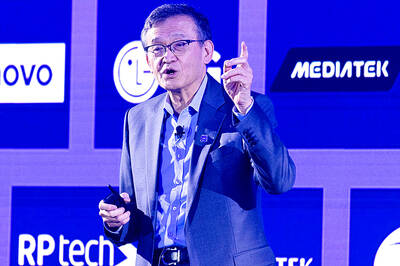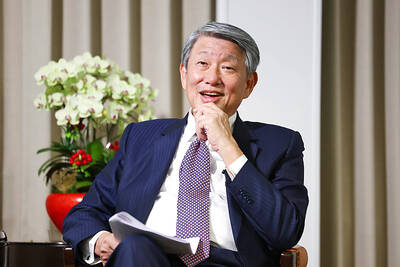You are on a train and suddenly a call comes in. You pull out a mobile device from your pocket to answer the call.
Later you receive a pop-up alert — “You’ve got mail!” — you unfold the device and the image expands to twice or even four times its original size. You fire off a quick reply to your boss using the virtual keyboard. Still later, you flip through the touchscreen panel to read the latest news updates or watch a YouTube video to kill time.
This isn’t a scene from a sci-fi movie, it is the future as envisioned by Liu Yingjian (劉迎建), founder of Beijing’s Hanvon Technology Co (漢王科技), the world’s second-largest maker of e-readers.

PHOTO: PATRICK LIN, AFP
Liu foresees the integration of PCs, cellphones, tablet devices and electronics readers into a single device that is foldable, portable and easy to use.
“We have had some client feedback saying they want to make calls from e-readers,” Liu said on Tuesday.
He predicted that e-readers and tablets would be the first products to merge.
E-readers, tablet devices, cloud computing and 3D technology have grabbed the spotlight at this year’s Computex Taipei.
Many of the new gadgets on display showed that the “trends” being discussed by tech industry experts are no longer the stuff of fantasy, but are really taking shape and likely to play an important role in life in the not too distant future.
Liu hails e-readers as a “revolutionary product” and a “critical breakthrough” that will write a new chapter in tech history.
“Audio and visual media have become digitized, now only words are not,” he said.
The revival of tablets and the emergence of e-readers is set to challenge traditional PC usage, paving the way for the next wave of personal digital products.
It is no longer necessary to be tech-centric to use gadgets because what consumers really want matters to companies. In fact, it matters a great deal to Asustek Computer Inc (華碩電腦). On Monday, chairman Jonney Shih (施崇棠) told a global press conference that “human-centric” would be the company’s product design philosophy for the future.
Tech products that the netbook computer pioneer plans to roll out will offer an improved human interface and features that are real time and real “human,” Shih said.
Despite causing a stir when it unveiled the industry’s first netbook PCs — stripped-down versions of standard notebooks that came with around 10-inch panels and a price tag of about US$500, in 2007 — the company is in less of a hurry to join the current craze for e-readers and tablets.
Asustek’s first e-reader will only hit the stores in Taiwan and the US in September.
“Our Eee Tablet offers different note templates, allowing students to scribble notes and sketches on the panels just like real paper,” Shih said.
Asustek is putting the launch on hold, in an attempt to make sure it comes up with a device that consumers really want.
In the case of the e-reader, the note-scribbling feature is pivotal as the education market is likely to account for the bulk of sales.
Asustek’s tablet, Eee Pad, will not be introduced until the first quarter of next year.
Apple Inc announced on Monday that 2 million iPads have been sold since the product launch less than two months ago. However, the iPad does not support Adobe Flash software. It also has no Web cam and USB ports.
Asustek is working to design an Eee Pad that differentiates itself from the iPad by offering those missing features.

Nvidia Corp CEO Jensen Huang (黃仁勳) today announced that his company has selected "Beitou Shilin" in Taipei for its new Taiwan office, called Nvidia Constellation, putting an end to months of speculation. Industry sources have said that the tech giant has been eyeing the Beitou Shilin Science Park as the site of its new overseas headquarters, and speculated that the new headquarters would be built on two plots of land designated as "T17" and "T18," which span 3.89 hectares in the park. "I think it's time for us to reveal one of the largest products we've ever built," Huang said near the

China yesterday announced anti-dumping duties as high as 74.9 percent on imports of polyoxymethylene (POM) copolymers, a type of engineering plastic, from Taiwan, the US, the EU and Japan. The Chinese Ministry of Commerce’s findings conclude a probe launched in May last year, shortly after the US sharply increased tariffs on Chinese electric vehicles, computer chips and other imports. POM copolymers can partially replace metals such as copper and zinc, and have various applications, including in auto parts, electronics and medical equipment, the Chinese ministry has said. In January, it said initial investigations had determined that dumping was taking place, and implemented preliminary

Intel Corp yesterday reinforced its determination to strengthen its partnerships with Taiwan’s ecosystem partners including original-electronic-manufacturing (OEM) companies such as Hon Hai Precision Industry Co (鴻海精密) and chipmaker United Microelectronics Corp (UMC, 聯電). “Tonight marks a new beginning. We renew our new partnership with Taiwan ecosystem,” Intel new chief executive officer Tan Lip-bu (陳立武) said at a dinner with representatives from the company’s local partners, celebrating the 40th anniversary of the US chip giant’s presence in Taiwan. Tan took the reins at Intel six weeks ago aiming to reform the chipmaker and revive its past glory. This is the first time Tan

CUSTOMERS’ BURDEN: TSMC already has operations in the US and is a foundry, so any tariff increase would mostly affect US customers, not the company, the minister said Taiwanese manufacturers are “not afraid” of US tariffs, but are concerned about being affected more heavily than regional economic competitors Japan and South Korea, Minister of Economic Affairs J.W. Kuo (郭智輝) said. “Taiwan has many advantages that other countries do not have, the most notable of which is its semiconductor ecosystem,” Kuo said. The US “must rely on Taiwan” to boost its microchip manufacturing capacities, Kuo said in an interview ahead of his one-year anniversary in office tomorrow. Taiwan has submitted a position paper under Section 232 of the US Trade Expansion Act to explain the “complementary relationship” between Taiwan and the US